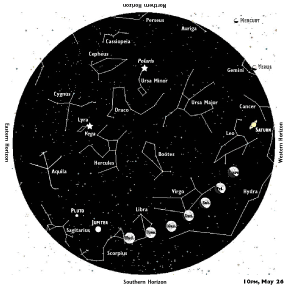|
|
 |
||||||||||
|
|||||||||||
|
|||||||||||
A Celestial Collision CourseBrilliant Vega heading our way
As the sun sets in the northwest around 8:25 this week, the brilliant star Vega rises in the northeast. The brightest of the three points in the Summer Triangle, Vega is the third-brightest star in the Northern Hemisphere, outshone by only Sirius and Arcturus, and fifth-brightest of all, including the Southern Hemisphere stars Canopus and Alpha Centauri. Twelve thousand years ago, Vega was earth’s North Star. Earth spins on a tilted 23/12-degree axis, but even so, its point of axis shifts over a 26,000-year cycle called the Precession of the Equinoxes. Imagine a wobbling top with its tip tracing an imaginary circle above. Right now we're about mid-way through the cycle, meaning that in another 10,000 years Vega will once again mark the north celestial pole. A relatively close neighbor, Vega is only 25.3 light years away, and in fact, it’s getting closer every second. The expansion of the universe caused by the Big Bang propels the star toward us at 10 miles a second! No need to panic, however, as it will take more than 5,000,000 years to reach us. By that time, Vega will have burned through its fusion-feeding hydrogen, collapsing into a white dwarf. Even in Vega’s short 400,000-year lifetime, astronomers believe it may already be forming its own solar system. In 1994, scientists studying Vega with the United Kingdom Infra-Red Telescope atop Mauna Kea, Hawaii, discovered a halo of cosmic dust encircling the star. Since then, other stars have revealed the same, and in some cases even the gravitational evidence of orbiting planets. That’s a good thing for those hoping for extra-terrestrial life, because it’s unlikely to be within Vega’s realm, considering it has taken our own solar system 4.6 billion years to develop. Illustration: © Copyright 1925 M.C. Escher/Cordon Art-Baarn-Holland; Graphics: © Copyright 2007 Pacific Publishers. Reprinted by permission from the Tidelog graphic almanac. Bound copies of the annual Tidelog for Chesapeake Bay are $14.95 ppd. from Pacific Publishers, Box 480, Bolinas, CA 94924. Phone 415-868-2909. Weather affects tides. This information is believed to be reliable but no guarantee of accuracy is made by Bay Weekly or Pacific Publishers. The actual layout of Tidelog differs from that used in Bay Weekly. Tidelog graphics are repositioned to reflect Bay Weekly’s distribution cycle.Tides are based on National Oceanic and Atmospheric Administration and are positioned to coincide with high and low tides of Tidelog. |
|||||||||||
|
|||||||||||
|
|
|||||||||||
|
© COPYRIGHT 2007 by New Bay Enterprises, Inc. All rights reserved. |
|||||||||||


